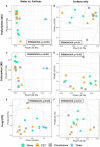High-Resolution Screening for Marine Prokaryotes and Eukaryotes With Selective Preference for Polyethylene and Polyethylene Terephthalate Surfaces
- PMID: 35495680
- PMCID: PMC9042255
- DOI: 10.3389/fmicb.2022.845144
High-Resolution Screening for Marine Prokaryotes and Eukaryotes With Selective Preference for Polyethylene and Polyethylene Terephthalate Surfaces
Abstract
Marine plastic debris serve as substrates for the colonization of a variety of prokaryote and eukaryote organisms. Of particular interest are the microorganisms that have adapted to thrive on plastic as they may contain genes, enzymes or pathways involved in the adhesion or metabolism of plastics. We implemented DNA metabarcoding with nanopore MinION sequencing to compare the 1-month-old biomes of hydrolyzable (polyethylene terephthalate) and non-hydrolyzable (polyethylene) plastics surfaces vs. those of glass and the surrounding water in a Mediterranean Sea marina. We sequenced longer 16S rRNA, 18S rRNA, and ITS barcode loci for a more comprehensive taxonomic profiling of the bacterial, protist, and fungal communities, respectively. Long read sequencing enabled high-resolution mapping to genera and species. Using previously established methods we performed differential abundance screening and identified 30 bacteria and five eukaryotic species, that were differentially abundant on plastic compared to glass. This approach will allow future studies to characterize the plastisphere communities and to screen for microorganisms with a plastic-metabolism potential.
Keywords: DNA metabarcoding; MinION; differentially abundant species; marine fungi; nanopore; plastic microbiome; plastisphere.
Copyright © 2022 Marsay, Koucherov, Davidov, Iankelevich-Kounio, Itzahri, Salmon-Divon and Oren.
Conflict of interest statement
The authors declare that the research was conducted in the absence of any commercial or financial relationships that could be construed as a potential conflict of interest.
Figures






References
-
- Andersen K., Kirkegaard R., Karst S., Albertsen M. (2018). ampvis2: an R package to analyse and visualise 16S rRNA amplicon data. bioRxiv [Preprint] 10.1101/299537 - DOI
LinkOut - more resources
Full Text Sources

